
16 minute read
Land-based multifunction
The IAI-Elta ELM-2248LB digital multi mission radar (DMMR) is the latest addition to the family of radar including the ELM-2084. The D-MMR is a fulldigital radar, performing digital beam forming by digitally sampling the signal at RF module level. @ IAI-Elta
Land-based multifunction 3D AESA radars
Advertisement
By Luca Peruzzi
The current strategic and tactical land scenarios in which armed forces are facing new threats, from tactical ballistic missiles to supersonic weapon systems, from airbreathing and unmanned air vehicles to rockets, artillery ammunition and mortar rounds (RAM), require highly-mobile, ground-based air surveillance radar systems capable to manage a wide range of targets simultaneously and to be integrated in modern GBAD (Ground Based Air Defence) systems operating in highly demanding cluttered environments. The new generation of 3D multifunctional radars centered on Active Electronically Scanned Antennas (AESA), based on Gallium Nitride (GaN) transmitter-receiver modules (TRMs), and on the latest processing hardware and software have been designed to cope with these threats and operational requirements, also offering reduced maintenance needs. European and Israeli companies cover an important percentage of the international market with in-service and new systems.
IAI-Elta Multi-Mission Radar family widespread
Originally developed for the Israeli Defense Forces (IDF) requirements and improved for the Iron Dome interception system, the IAI-Elta MMR (Multi-Mission Radar) family of radars including the ELM-2084 has grown and evolved to offer air surveillance, air defence, counter-rockets, -artillery and -mortar (C-RAM), hostile artillery weapon location, as well as friendly fire ranging
IAI-Elta ELM-2084 MMR (Multi-Mission Radar) has evolved to offer air surveillance, air defence, C-RAM, sense and warn, being the main sensor for Iron Dome, David’s Sling and Barak missile systems. © IAI-Elta

capabilities, for both national and worldwide international customers. In addition to being the main sensor for Rafael Iron Dome, the ELM-2084 performs the same function for Rafael David’s Sling air and missile defence system and IAI’s Barak weapon family systems. The latest addition to the S-band MMR family of multifunction AESA radars is the full-digital ELM-2248LB Digital-MMR (D-MMR). According to Elta it is a four-dimensional (4D) full phased array (both in azimuth and elevation) radar, implementing AESA technology based on Gallium Nitride (GaN) transmitter-receiver modules (TRMs) and scalable solid-state phased array. The D-MMR performs digital beam forming (DBM) by digitally sampling the signal at TRM module level, delivering high situational awareness picture and weapon support for current and emerging threats under severe environmental conditions. Characterized by high mobility and fast deployment, including air transportability with C-130 aircraft, with different power generation configurations on trailer or shelter depending on radar version and customer needs, in the air surveillance mode the ELM-2248 LB radar has an instrumental range of up to 400 km. With a sectorial 120° or 360° azimuth coverage rotating up to 30 revolutions per minute (RPM), the ELM-2248LB features an elevation coverage up to 70° with high accurate 3D measurement and up to 1,100 targets capacity. The FCR (Fire Control Radar) functionality provides midcourse guidance of active/semi-active surfaceto-air missile systems. In the C-RAM mode, the radar has a detection range of 100 km with a 120° azimuth and up to 90° elevation coverage, with a 0.3% CEP and a tracking capability of 200 targets/min. In mid-2019, IAI Elta unveiled another radar derived from the ELM-2084 and called Multi-Sensor MMR, which adds multispectral capabilities to counter emerging threats with the addition of a higher frequency radar, an active IFF, an automatic dependent surveillancebroadcast (ADS-B) receiver, as well as passive EO/IR and signal intelligence sensors, in addition to optional passive sensors for detecting weapons being launched.
Shifting to the C-band, the ELM-2311 CompactMMR (C-MMR) exploits the same architecture of the aforementioned radars and is a highly mobile and transportable all-in-one radar system featuring a reduced-sized GaN-based TRM AESA antenna, which together with the power generation unit and two operator consoles including communication equipment, can be installed on board a single vehicle for maneuvering forces. The C-MMR performs the same functions of the bigger versions with reduced ranges. In the air-defence and WLR modes, the system has respectively a 250 and 70 km range with 360° rotating or 90-120° starring antenna modes, up to 50° in elevation and over 100 targets/min. The MMR radar family found international success with over 100 systems sold
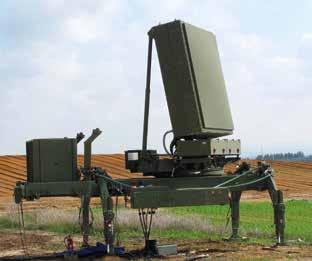
The ELM-2084 MMR (Multi-Mission Radar) comes in a family of 3D multifunction radars in both S-Band and C-Band and in different configurations such as the latest Multi-Sensor MMR or the smaller ELM-2311 highly-mobile version. © IAI-Elta
and in service with demanding disclosed and undisclosed customers including Canada, India, Singapore, Finland, Vietnam and more recently the Czech Republic and the United States. The latter’s Army is to receive two Iron Dome batteries equipped with the MMR radar within 2020.
Hensoldt’s TRML-4D readies for delivery
The land-based version of Hensoldt newest 4D AESA radar family is expected to be delivered to the first customer in 2020. Designated TRML4D and based on the same overall system architecture of the well-known and already in service naval TRS-4D version, the land-based radar shares the same GaN solid-state TRMs and software-defined AESA array operating in the C-band. The TRML-4D is designed for remote-controlled air surveillance and to act as fire control sensor for short and medium range air defence weapon systems and differs from the naval TRS-4D version for a larger rotating antenna without the constraints of the ship mast-mounted installation. With an instrumented range of up to 250 km and able to reach 30,000 meters height with and elevation coverage between -2° and 70° (electronically tilt-down to -10°) and tracking up to 90°, thanks to the AESA array and multiple digitally formed beams and Doppler processing the new radar provides accurate track-whilescan function combined with high-precision 3D tracking of dedicated targets enabling the

The first Hensoldt TRML-4D is to be delivered, as part of a Diehl-provided IRIS-T SLM GBAD system package with launchers and Airbus Defence and Space Tactical Operation Centre (TOC), to an international non-NATO customer in 2020. © Hensoldt
creation of reliable air pictures with particular emphasis on small, fast, and low-flying unmanned system and/or maneuvering cruise missiles, aircraft and hovering helicopters. Thanks to the AESA-based ‘cued track’ functionality enabling to establish a track within the first rotation with an update rate of less than one second, the TRML-4D can track over 1,500 targets as well as being able to automatically trigger electronic counter-measures to prevent saturation jamming. The AESA radar antenna is integrated with an IFF system with the latest Mode S and 5, and all the system package is based on a platform transportable on high-mobility 8x8 vehicles, with
The Hensoldt TRML-4D is based on the same system architecture of the well-known and already in-service naval C-band TRS-4D version, sharing the same GaN solid-state transmitter TRMs and software-defined AESA array system. © Hensoldt
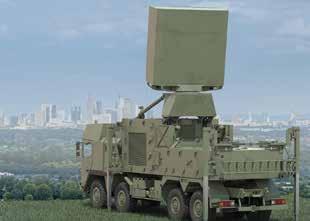
an in and out of action time of 10 minutes, and with roll-on/roll-off capability for transport by rail, ship, A400M/C-130 Hercules aircraft. As anticipated, series production has already started and the first TRML-4D is to be delivered, as part of a Diehl-provided IRIS-T SLM GBAD system package with launchers and Airbus Defence and Space Tactical Operation Centre (TOC), to an international non-NATO customer in 2020.
Leonardo’s Kronos family enlarges
Exploiting the technological and operational developments carried out for the C-band fully AESA Kronos Naval MFRA (Multi-Function Radar Active), part of the SAAM ESD air defence system with MBDA Aster 30 missile family, Leonardo developed
the Kronos Grand Mobile and the smaller Kronos Land radars; all the aforementioned products are in production for Italy as well as for international customers. The Kronos Grand Mobile system was specifically designed for high tactical mobility and quick strategic deployment of the Kronos Grand fully AESA 3D multifunction radar with the latest signal processing developments to optimise detection, tracking, threat classification and missile guidance against multiple air and maritime highand low-speeds reduced RCS targets including TBMs, even in heavy clutter environments. With a full active phased array antenna populated by solidstate GaAs TRMs rotating at 60 rpm and capable of azimuth and elevation monopulse for high accuracy tracking, the Kronos Grand radar has optimized surveillance modes including a defensive one for fast reaction, air surveillance as well as rotating and ‘starring’ TBM modes. Capable of simultaneous multiple target tracking with update rate up to one second for highly manoeuvring dangerous threats and fast tracking initialization (one second after first detection) together with weapon cueing and engagement control of third party’s new activeguided anti-air missile-based GBAD, the radar has an air surveillance and defence instrumented range of respectively over 300 and 250 km, a 30,000 meters ceiling, an elevation coverage of respectively 70°+ and 90° in surveillance and tracking modes, together with over 1,000 tracks and 30 contemporary engaged targets. With an optional C-RAM capability, the radar comes with extended ECCMs and integrated IFF transponder
Exploiting the technological and operational developments of naval Kronos radars, Leonardo developed the land-based Kronos Grand Mobile system selected and under production for international and national customers. © Leonardo
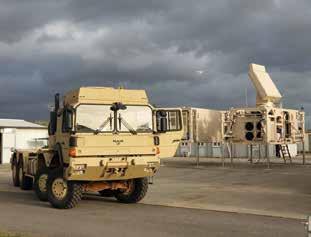
Leonardo offers the Kronos Land mobile multifunction radar centred on a smaller-size full active GaAs technologybased TRMs populated AESA antenna which has found international success on both naval and land applications. © Leonardo

phased array antenna with the latest military/civil modes, being capable to be connected to up to three C2 centres simultaneously. In addition to the radar system containerized module and the power generator trailer, the Kronos Grand Mobile can be supplied with an optional C3 20’ ISO module with three C2 workstations and a communications suite including Leonardo Multiple Data Link Processor (M-DLP). The Kronos family systems are the main component of the Low-Level Radar System developed for the Qatar Armed Forces. The Italian Army also selected the Kronos family to support its Integrated Air and Missile Defence (IAMD) capability. Leonardo is currently working on the Kronos Quad radar, based on four fixed faces C-band AESA system using the GaN-technology, as part of the Dual Band Radar (DBR) for the Italian Navy’s new Pattugliatore Polivalente d’Altura (PPA). According to the Programmatic Multi-Year Document (DPP, Documento Programmatico Pluriennale) 2018-2020, a programme to develop a multifunction land-based radar based on the so-called Kronos Grand Mobile High Power (HP) version for the Eurosam SAMP/T Ground-Based Air Defence (GBAD) system is part of the Italian
MoD plans. No details have been released but the new HP version is expected to be based on the more powerful GaN TRMs under development for naval applications. Leonardo also offers the Kronos Land mobile multifunction radar centred on the smaller-size full active GaAs TRMs populated AESA antenna which has found international success on both naval and land applications. Integrated in a single ISO 20’ container module together with power generation and three workstations for both radar and weapon control, the Kronos Land has been designed and proven to support both air and coastal defence tactical operations as well as to control SHORAD and VSHORAD systems with both semi-active and fully active missiles. The system is under production for both the Italian Air Force’s Sirius GBAD system, based on MBDA’s CAMM-ER effector, and for the Bangladesh air force.
Saab’s Giraffe 4A delivers
Introduced to the market in 2014 and building on the technology already applied to the Saab’s Arthur weapon locating radar and Giraffe AMB medium-range surveillance radar product families, the all-new medium-long range S-band 3D multifunction Giraffe 4A radar based on the GaN AESA technology is currently under production and delivery for Sweden’s Defence Material Administration (FMV) launch customer as part of a contract awarded in late 2018 for an undisclosed number of vehicle-mounted systems. Designed according to the latest customers’ multifunction
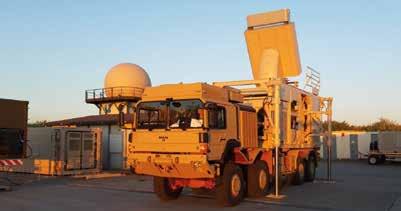
The Kronos family systems are the main component of the Low-Level Radar System developed for the Qatar Armed Forces. The Italian Army also selected the Kronos family to support its Integrated Air and Missile Defence (IAMD) capability. © Leonardo The all-new medium-long range S-band 3D multifunction Giraffe 4A radar based on GaN AESA technology is currently under production and delivery for Sweden’s Defence Material Administration (FMV) launch customer under a contract awarded in late 2018 for an undisclosed number of vehicle-mounted systems. © Saab
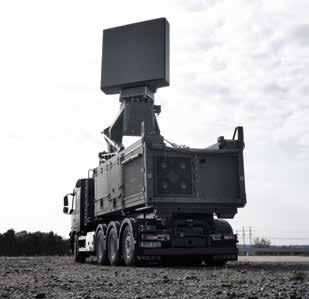
requirements, the Giraffe 4A is a stacked beam 3D radar integrating the proven functionalities from Arthur and Giraffe AMB, namely the latter Medium Pulse Doppler waveform, with a digital AESAbased GaN-TRMs populated antenna architecture, and digital beam forming and control in azimuth and elevation. The new radar is capable to offer simultaneous air surveillance and GBAD target acquisition together with weapon locating and sense and warn capacity without performance degradation, says Saab. With a 30 or 60 rpm rate, the Giraffe 4A can search in the entire volume or conduct an optimized search in a sector (40°- 120°) with a starring mode, in both cases with a 70° elevation. With an instrumented air surveillance and weapon locating range of respectively 280 and 100 km, and integrated with an IFF antenna, the Giraffe 4A can manage over 1,000 air tracks in the air surveillance and over 100 tracks per minute in the weapon locating modes. With a great emphasis on ECCM performances in the radar design, the latter was developed to accommodate new-software based functionalities including the Saab-proprietary Enhanced Low Small and Slow (ELSS) mode allowing the detection of very small radar cross section (RCS) targets such as drones and birds and distinguish among them, says Saab. The Giraffe 4A is integrated and self-contained with power generation into a 16’ modular pallet
platform and is designed to be operated locally or by remote control. Local operation is executed with a ruggedized PC in close connection to the system, but a 4’ control element can be optionally added to the system module with a twin-station operator cabin. With a mean time between critical failures of over 2,500 hours, it can be deployed by two persons in less than 10 minutes and be ready to move in less than five minutes, being transportable by a single C-130 or larger aircraft, in the latter case as drive/drive-off cargo.
Thales’ new generation Ground Fire system
During Paris Air Show 2017, Thales unveiled the Ground Fire family of 3D fully digital AESA S-band radars for both air defence and surveillance against a wide range of challenging threats, among which ballistic missiles. This is the mobile single-antenna rotating land-based version of the Sea Fire four fixed-faces AESA multifunction radar currently under testing and evaluation at DGA facilities before being delivered to Naval Group to equip the French Navy Frégates de Défense et d’Intervention (FDI). In parallel to the Sea Fire naval programme, the French MoD decided to launch the development of the singlerotating antenna land-based mobile radar, featuring the same technology architecture. The Ground Fire 300 (GF 300) version is destined, according to Thales, to replace the Arabel radar around 2025 as part of the Eurosam SAMP/T GBAD New Generation (NG) programme together with command and control renewal and new generation MBDA Aster 30 Block 1NT ammunition to cope with more capable ballistic missiles threats. The new 3D radar antenna and its rotating and processing equipment is integrated on a standard ISO 20’ platform to be carried by a high-mobility 8x8 vehicle with the power generation on board a trailer, according to released video. The Ground Fire is a scalable, software-controlled 3D multifunction radar designed to perform various tasks including volume search, low altitude surveillance, air target tracking, environment mapping, fire control, full uplink support for Aster missile, and kill assessment. According to Thales, the fully digital radar is able to simultaneously detect and track a comprehensive range of targets such as ballistic threats, with continuous 360° coverage in azimuth, up to 90° coverage in elevation and a range of 400 km. Based on the solid-state GaN high-power amplifier technology, the Ground Fire features a modular, liquid-cooled AESA antenna design, which can be scaled according to mission needs. The GF 300 version differs from the Sea Fire version for the FDI frigates for a higher number of TRM assemblies in the larger antenna for single-face rotating operations with co
The Giraffe 4A is a stacked beam 3D radar integrating the proven functionalities from Arthur and Giraffe AMB, with a digital AESA-based GaN-TRMs populated antenna architecture, and digital beam forming and control in azimuth and elevation. © Saab
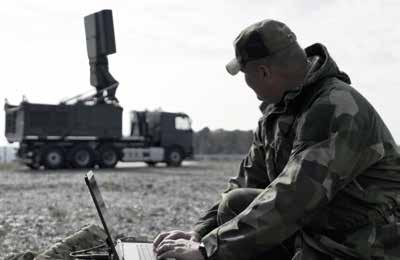
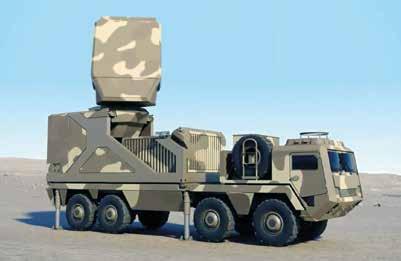
The Thales Ground Fire is the mobile single-antenna rotating land-based version of the Sea Fire naval four fixed-faces AESA multifunction naval radar. The Ground Fire 300 version is destined to replace the Arabel radar around 2025 as part of Eurosam SAMP/T GBAD New Generation (NG) programme. © Thales
In November 2019, The Netherlands Defence Materiel
Organization (DMO) awarded
Thales a contract for nine MultiMission Radar (MMR) or GM200
MM/C systems specifically customized in collaboration with the DMO and the Royal Netherlands Army (RNLA). © Thales

mounted IFF antenna, allowing for autonomous ballistic defence. Maintaining the same software and hardware architecture, it allows for new software-defined functionalities to be added in response to new missions and threats, as well as reduced maintenance and support requirements.
Ground Master 200 evolution
Based on the so-called 4D AESA radar developments from both Thales France and Nederland, the Group developed the latest Ground Master 200 Multi-Mission All-in-One (GM200 MM/A) system, alongside the Ground Master 200 MM Compact (GM200 MM/C), both operating
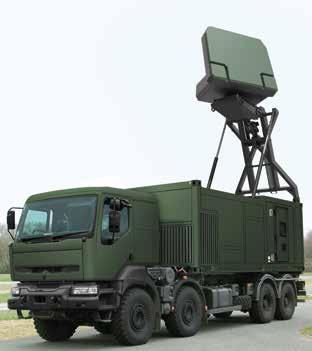
Benefiting on the combat proven family predecessor, the new GM200 MM/A integrates a new fully-digital and software-defined AESA radar with a new GaN solid-state TRMs-based phased array, maintaining the same single and autonomous 20’ ISO standard container with C2. © Thales
in the S-band. Benefiting on the combat proven platform which served successfully around the world with over 100 radars in use in around 20 countries, the new GM200 MM/A integrates a new fully-digital and software-defined AESA radar with a new GaN solid-state TRMs-based phased array, IFF and processing, maintaining the same single and autonomous 20’ ISO standard container including power generator unit, antenna elevating mast for low-level air surveillance and room for two work stations with a communications suite. While offering operators 40% longer range capabilities, according to Thales, the dual-axis multi-beam technology radar can analyze between 16 and 30 separate beams, which means enhanced ability to isolate targets from the background, more time-ontarget and multiple simultaneous targets tracking including drones. The Ground Master 200 MM/C is a pallet version offering higher tactical mobility and quicker deployment as required by some specific missions like artillery counter battery and weapon locating. It also suites well VSHORAD/ SHORAD missions as its GM200 MM/A brother. In November 2019, the Netherlands Defence Materiel Organization (DMO) awarded Thales a contract for nine Multi-Mission Radar (MMR) or GM200 MM/C systems specifically customized in collaboration with the DMO and the Royal Netherlands Army (RNLA) for the latter service under the ‘C-RAM and Class 1-UAV detection capability’ project. Both versions are in advanced stage of development with first serial units’ deliveries in 2021.





